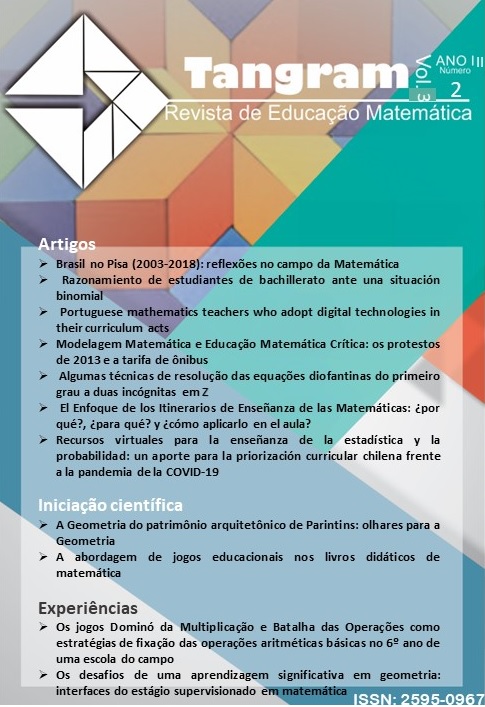The Geometry of the architectural heritage of Parintins: looks at Geometry
DOI:
https://doi.org/10.30612/tangram.v3i2.10130Keywords:
Architectural Heritage. Geometric strokes. Geometry teaching.Abstract
This article presents the results of a research carried out within the scope of the Scientific Initiation Support Program (PAIC), from the State University of Amazonas (UEA), with support from the Research Support Foundation of the State of Amazonas (FAPEAM). The objective of the research is to highlight relationships that can be established from the identification of the properties of the mathematical objects identifiable in the buildings that make up the architectural heritage of the city of Parintins-AM. The research is qualitative and built data through direct, systematic observation, and photographic records. The analysis took place through a triangulation of the results obtained, which indicate that the geometric features identified in the architectural heritage of Parintins have the potential to constitute a pedagogical path that contextualizes the teaching of geometry and values the history of the city.Downloads
References
Albuquerque, M. (2017). Museu Nacional Etrusco de Villa Giulia. Belo Horizonte, Janeiro de 2017. Disponível em:
https://historiaartearquitetura.wordpress.com/2017/01/12/museu-nacional-etruscode-villa-giulia/. Recuperado em: 08/05/2019.
Amorim, A. L. (2017). A documentação arquitetônica como uma atividade multi, inter e transdisciplinar. Ponto de Acesso, v.11, n.1, pp. 61-84.
Barison, M. B. (2005). Definições e figuras relativas ao estudo de Arcos em Desenho Geométrico – Resumo. Geométrica, v.1, n.8, pp. 1-4. Recuperado em: www.mat.uel.br/geometrica.
Borralho, A., Fialho, I., & Cid, M. (2015). A Triangulação Sustentada de Dados como Condição Fundamental para a Investigação Qualitativa. Revista Lusófona de Educação, v. 29, pp. 53-69.
Costa, L. F. M. da., Souza, E. G. de & Lucena, I. C. R. de. Complexidade e pesquisa qualitativa: questões de método. Perspectivas da Educação Matemática – PEM, v. 8, número temático – 2015, pp. 727-748.
Creswell, J. W. (2010). Projeto de Pesquisa: métodos qualitativo, quantitativo e misto. Porto alegre: Artmed.
Derenji, J. S. (1998). Arquitetura Nordestina: a presença italiana no início do século XX. Manaus: Edições do Governo do Estado do Amazonas.
Fabris, A. (1993). Arquitetura eclética no Brasil: o cenário da modernização. Anais Do Museu Paulista: História e Cultura Material, v.1, n. 1, pp. 131-143. Recuperado em: https://doi.org/10.1590/S0101-47141993000100011.
Furlanetto, E. C. (2014). Interdisciplinaridade: uma epistemologia de fronteiras. In: BERKENBROCK-ROSITO, M. M., HAAS, C. M. (orgs). Interdisciplinaridade e Transdisciplinaridade: políticas e práticas de formação de professores. Rio de Janeiro: Wak. p. 57-74.
Gil, A. C. (2008). Métodos e técnicas de pesquisa social. São Paulo: Atlas.
Gil, R. S. A. (2011). Ensino de Matemática e o Patrimônio histórico-cultural: possibilidades interdisciplinares para a Amazônia. Anais do 13º Congresso Internacional de Educação Matemática - XIII - CIAEM-IACME. Recife.
Iezzi, G. (1993). Fundamentos da Matemática Elementar: Trigonometria. São Paulo: Atual.
Dicionário da Língua Portuguesa. (2019). Porto: Porto Editora. Disponível em: https://www.infopedia.pt/dicionarios/lingua-portuguesa/flecha. Recuperado em 03/04/2019.
Loizos, P. (2012). Vídeo, filme e fotografia como documento de pesquisa. In: BAUER, M. W., & GASKEL, G. Pesquisa qualitativa com texto, imagem e som: um manual prático pp. 137-155. Petrópolis, RJ: Vozes.
Madalena, M. S. (2007). A matemática da arquitetura ideal. Recuperado em: http://www.exatas.ufpr.br/portal/docs_degraf/artigos_graphica/a%20matematica%20d a%20arquitetura%20ideal.pdf.
Mendes, I. A., & Gil, R. S. A. (2017). Patrimônio histórico e arquitetônico no ensino de matemática: experiências didáticas na formação de professores de matemática. Belém: SBHMat.
Moreira, M. A. (2002). Pesquisa em educação em ciências: métodos qualitativos. Programa Internacional de Doctorado en Enseñanza de las Ciencias. Universidad de Burgos, Espanha; Universidade Federal do Rio Grande do Sul, Brasil. Texto de Apoio n° 14. Actas del PIDEC, v. 4, pp. 25-55.
Santos, A. P. M., & Barbosa, T. R. (2018). O patrimônio histórico do núcleo central de Parintins-AM: mudanças e permanências. Recuperado em: http://repositorioinstitucional.uea.edu.br/handle/riuea/816.
Downloads
Published
How to Cite
Issue
Section
License
Authors must accept the publication rules when submitting the journal, as well as agree to the following terms:
(a) The Editorial Board reserves the right to make changes to the Portuguese language in the originals to maintain the cultured standard of the language, while respecting the style of the authors.
(b) Authors retain the copyright and grant the journal the right to first publication, with the work simultaneously licensed under the Attribution-NonCommercial-ShareAlike 3.0 Brazil (CC BY-NC-SA 3.0 BR) that allows: Share - copy and redistribute the material in any medium or format and Adapt - remix, transform, and create from the material. CC BY-NC-SA 3.0 BR considers the following terms:
- Attribution - You must give the appropriate credit, provide a link to the license and indicate whether changes have been made. You must do so under any reasonable circumstances, but in no way that would suggest that the licensor supports you or your use.
- NonCommercial - You may not use the material for commercial purposes.
- Sharing - If you remix, transform, or create from material, you must distribute your contributions under the same license as the original.
- No additional restrictions - You may not apply legal terms or technological measures that legally restrict others from doing anything that the license permits.
(c) After publication, authors are allowed and encouraged to publish and distribute their work online - in institutional repositories, personal page, social network or other scientific dissemination sites, as long as the publication is not for commercial purposes.






